📌 TL;DR — Minimum ham radio gear at a glance
- Start with VHF: One dual-band handheld, stock antenna, charger, and a way to program local repeaters.
- Add HF later: HF radio with built-in tuner, basic HF antenna, 50 Ω coax, and a 13.8V DC power supply.
- Two categories: VHF covers local repeaters and emergency nets; HF reaches other states and countries.
- Keep it simple: Buy one solid radio in each category and a small set of proven accessories.
- Examples in this guide: Baofeng UV-5RM Plus for VHF and Xiegu G90 with an HF portable antenna for HF.

Before you buy anything: what "minimum gear" really means
If you just passed your ham exam (or you're studying for it), it's easy to get overwhelmed by gear videos and spec sheets.
This guide keeps things grounded: we'll look at the minimum practical gear you need to get on the air, split into
two buckets — VHF and HF — with real examples from Radioddity so you have concrete shopping ideas.
"Minimum" doesn't mean junk gear. It means the smallest, simplest setup that still works well for real-world
radio use: talking on local repeaters, checking into nets, and eventually making HF contacts across the country and beyond.
We'll start with VHF (the cheaper, easier path), then move into HF once you're ready for longer-distance contacts.
Along the way we'll point to more radio articles and other projects on
BrokenSignal.tv if you want to go deeper later.
The VHF starter kit: simple, cheap, local communications
For most new hams, the first radio is a dual-band VHF/UHF handheld. This gets you on local repeaters,
simplex (radio-to-radio) contacts, and many emergency and weather nets, all for the price of a modest dinner out.
Minimum VHF gear checklist
Here's the minimum setup that will actually work in the real world:
- Dual-band VHF/UHF handheld (2 m / 70 cm)
- Stock battery and charger
- Stock antenna (plus an upgraded whip later)
- Simple programming method (software + cable or a friendly club member)
- Basic carry method (belt clip, lanyard, or case)
Example handheld: Baofeng UV-5RM Plus
A good example of a "first radio" is the Baofeng UV-5RM Plus from Radioddity. It's a budget-friendly
dual-band handheld with up to 10 W of power, 999 memory channels, expanded receive (including airband on VFO), and USB-C
charging options, depending on the bundle you pick.
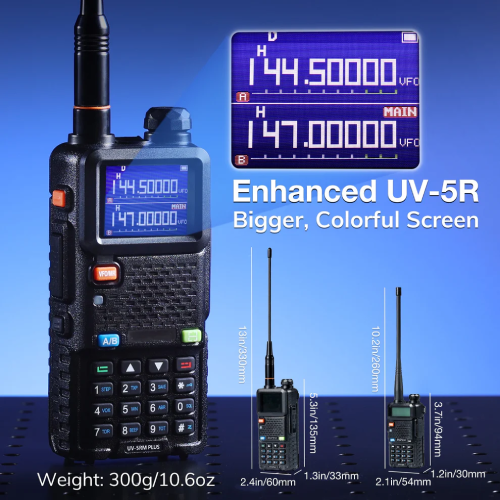
With one of the multi-pack bundles you get extra antennas, batteries, and a desktop charger, which can save you money
versus buying those parts later. Out of the box, this radio will get you on your local repeaters once it's programmed.
Example antenna upgrade: Radioddity RD-771
The stock "rubber duck" antenna works, but it's not great. A cheap and popular upgrade is a longer high-gain whip like
the Radioddity RD-771, a dual-band SMA-F antenna designed for Baofeng and similar handhelds. It offers
improved gain on 2 m and 70 cm and is flexible enough for field use.
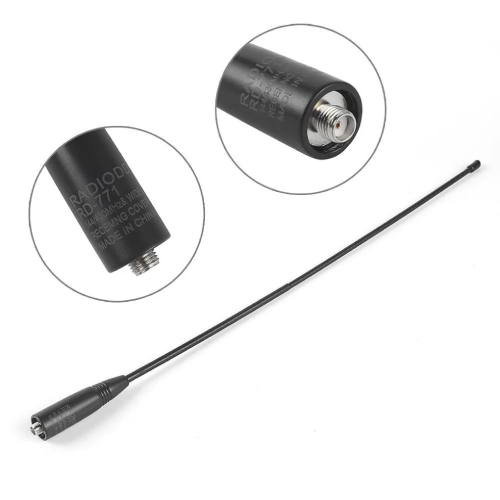
Programming your first handheld
The hardest part of your first VHF radio is often programming repeaters. Most people don't key in dozens of channels by hand;
instead they use a programming cable and software like CHIRP to load in a channel list.
Radioddity carries a range of programming cables
that work with Baofeng and Radioddity radios. Pair one of those with your UV-5RM Plus and you can back up, edit, and restore
your channel list at any time.
VHF "minimum vs nice-to-have" comparison
| Item |
Minimum to get on the air |
Nice-to-have upgrade |
| Radio |
1× Baofeng UV-5RM Plus |
Second handheld for a family member or backup |
| Antenna |
Stock short whip |
Radioddity RD-771 or similar high-gain whip |
| Power |
Included Li-ion battery + USB-C or desk charger |
Spare battery pack for long outings |
| Programming |
Manual keypad programming of a few repeaters |
Programming cable + CHIRP with a full local repeater list |
| Audio |
Built-in speaker/mic |
Speaker mic or earpiece for noisy environments |
The HF starter kit: reaching beyond the horizon
VHF keeps you close to home. HF (shortwave) is where you start talking to other states and countries, checking into regional
nets, and working events like POTA and SOTA. HF is more expensive and a bit more complex, so think of this as
"Phase 2" of your ham journey.
At a minimum, an HF station needs:
- HF transceiver (radio)
- Some form of antenna tuner (built-in or external)
- HF antenna
- 50 Ω coaxial cable (feedline)
- 13.8V DC power supply or battery that can handle the radio's current draw
Example HF radio: Xiegu G90 (with built-in tuner)
The Xiegu G90 is a compact 20 W HF SDR transceiver that covers 10–160 m, has a detachable front panel,
and — most importantly for beginners — includes a built-in automatic antenna tuner. That tuner lets you
match a simple wire or portable vertical across multiple bands without buying a separate tuner right away.
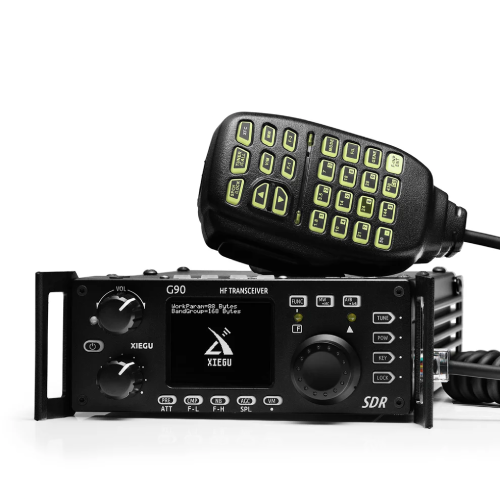
With a radio like the G90, the minimum add-ons are just coax and an antenna. That keeps the parts list short:
radio, power, coax, antenna, and you're on the air.
Example HF antennas: portable verticals and simple wires
For your first HF antenna, think "easy to deploy, not too expensive, and tunable." Radioddity sells compact multi-band
verticals like the HF-008 and my personal favorite the HF-009, which cover roughly 80 m–6 m or 60 m–6 m with
SWR typically in the 1.0–1.5 range when adjusted correctly.
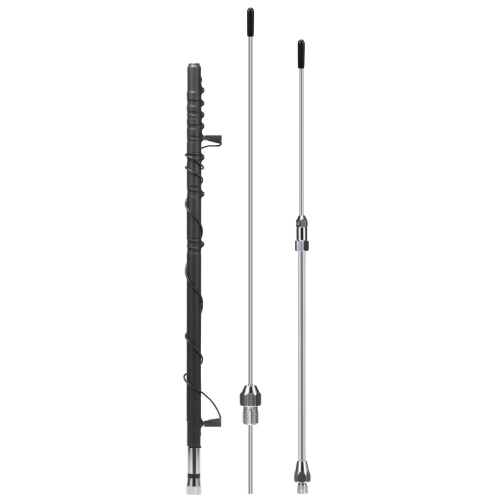

If you want a more permanent home setup, a vertical like the Xiegu VG4 (40/20/15/10 m multi-band base
antenna) is another option once you're ready to invest in a fixed station antenna system.
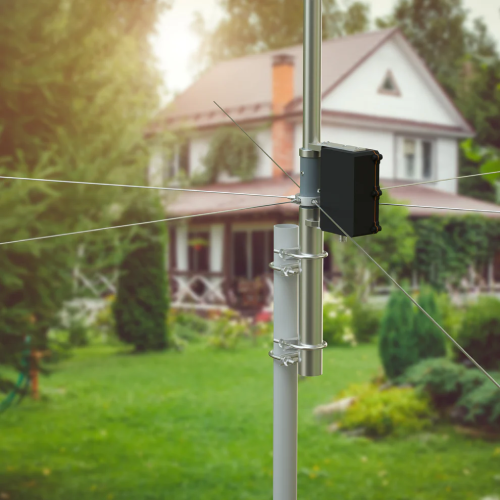
Example power supply: Radioddity PS30
Most HF radios expect about 13.8V DC at 20–25 A for full power. The Radioddity PS30 is a compact
switching DC supply with adjustable 8–15V output (fixed 13.8V mode) and up to 30 A peak / 20 A continuous current,
which is plenty for a 20–100 W class radio and accessories.
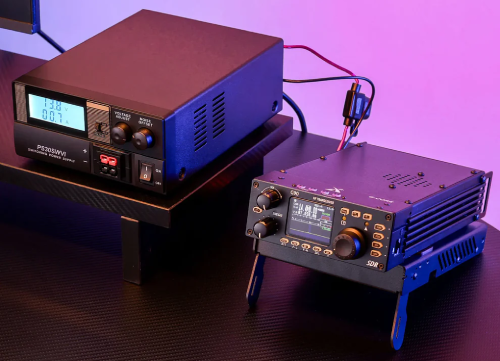
HF "minimum vs nice-to-have" comparison
| Item |
Minimum to get on the air |
Nice-to-have upgrade |
| Radio |
Xiegu G90 (20 W, built-in tuner) |
Higher-power HF radio or QRP rig + external amp later |
| Antenna |
HF-008/HF-009 portable vertical or a simple wire |
Permanent multi-band vertical (Xiegu VG4) or full wire antenna farm |
| Tuning |
Built-in tuner in the radio |
External tuner for more extreme antenna setups |
| Power |
PS30 or similar 13.8V supply |
Battery+solar setup for off-grid HF operation |
| Monitoring |
Radio's built-in speaker |
External speaker or headphones for weak-signal work |
VHF vs HF: which should you buy first?
If your budget is tight, start with VHF. A UV-5RM Plus and a better antenna cost a fraction of an HF
station, and you'll immediately be able to:
- Talk on local repeaters and nets
- Carry a radio while hiking, traveling, or storm spotting
- Listen to local emergency and weather traffic
Once you're comfortable with on-air etiquette and repeater use, you'll know whether an HF station is worth the extra
investment for how you actually operate.
If your budget allows both, a "VHF handheld + modest HF station" is a very capable combo that covers
local and long-distance communications for emergency use, hobby operating, and experimentation.
A simple 4-step plan to get on the air
-
Get licensed and find local activity.
Use a repeater directory and your local radio club to learn which VHF repeaters and HF nets are active in your area.
-
Buy your VHF starter kit.
Pick up a UV-5RM Plus (or similar), a programming cable, and a better antenna like the RD-771. Get 5–10 local repeaters
loaded into memory.
-
Operate for a few weeks.
Check into local nets, monitor severe weather, and talk to club members. Take notes on what you wish your station
could do that it can't do yet.
-
Add HF intentionally.
When you're ready for longer-range contacts, build an HF station around a simple rig with a built-in tuner (like the G90)
and a portable or base HF antenna. Grow from there as your interests and budget allow.
FAQ: minimum ham radio gear questions
Do I need a license before buying any of this?
You can buy the gear anytime, but you must be licensed to transmit on ham bands. Studying while your
first radio is on the way can be a great motivator. Once your callsign shows up in the database, you're good to go.
Is one handheld really enough for emergencies?
One handheld is way better than none. It lets you reach local repeaters and other hams who may be coordinating during
severe weather or local incidents. Over time, many operators add a mobile radio in the car and a
base station at home — but you don't have to buy that all on day one.
How far will a VHF handheld actually reach?
With a stock antenna, expect a few miles simplex and much farther via a local repeater on a good hill.
With a better antenna (RD-771) and clean line of sight, you can often hit repeaters 20–30 miles away, depending on terrain
and height. If you need mesh-style off-grid coverage, take a look at the projects over on Meshtastic.
Do I really need an antenna tuner if my HF radio already has one?
A built-in tuner like the one in the G90 is usually enough for basic portable antennas and slightly off-resonant wires.
An external tuner becomes helpful once you start experimenting with more "creative" antennas or when you want to use one
antenna across a very wide frequency range with higher power.
What should I upgrade first after the minimum gear?
On VHF, your antenna and programming are the best early upgrades. On HF, the next big quality of life
improvements are a more efficient antenna system and a comfortable operating position (desk, external speaker, good
headphones, logging software, etc.).
Wrapping up: build a station that matches how you actually operate
You don't need a room full of radios to be a "real" ham. A single handheld and a
small HF station — built with intention — can cover 90% of what most operators actually do.
Start with VHF, learn the ropes, then grow into HF when you're ready. Use trustworthy gear from places like
Radioddity (don't forget the BrokenSignal referral link),
and focus on antennas and operating skill more than shiny knobs.
When you're ready for the next step, check out the Radio section here on BrokenSignal.tv,
explore more builds in Tech, and start planning your first real HF contact from the shack,
campsite, or off-grid cabin.